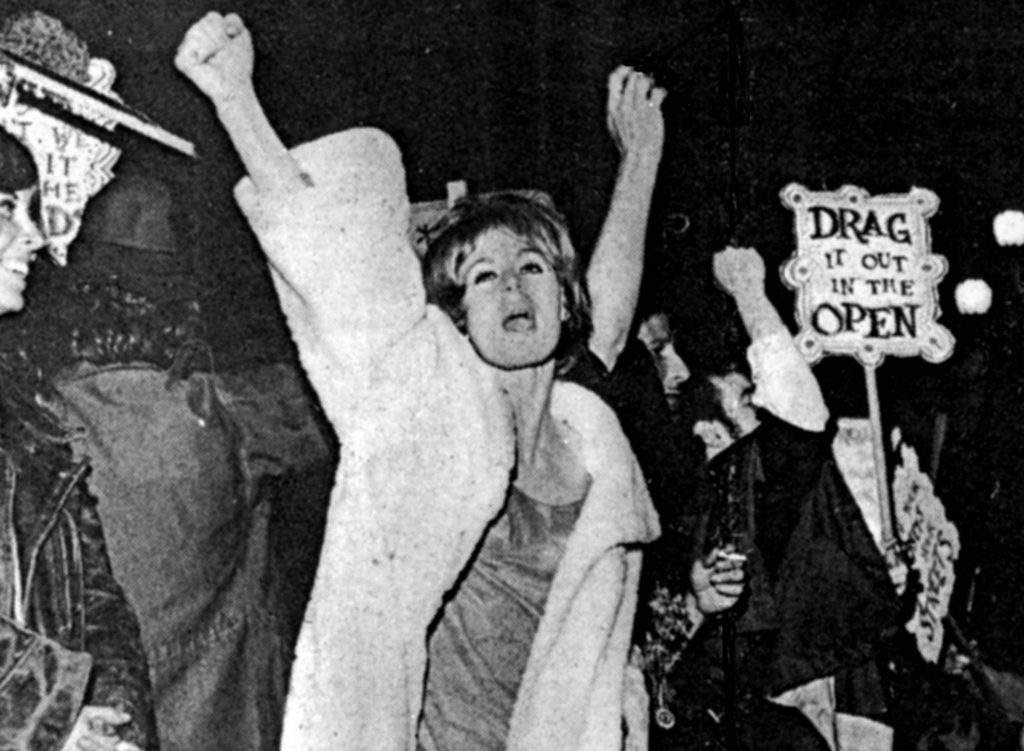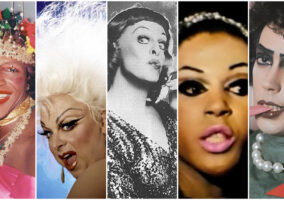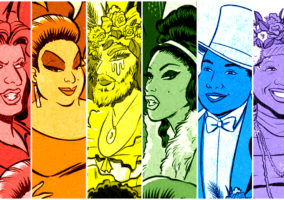
When it comes to writing about history from a specific point of view (say, when you’re putting together a book about the history of queer culture in relation to RuPaul’s Drag Race, just to pull a wild and unrelated example out of our pretend hats), one of the more difficult aspects of the task is where to place the first pin on the timeline so that you can launch into your take. There’s no start to history and (at least for now) there’s no end to it. It’s just a long, unbroken chain of events, many of which are discrete unto themselves; many more of which relate to, respond to, or are echoes of previous events on the chain. We don’t count ourselves as historians, but one thing we’ve learned in writing about history is that you have to choose your insertion point and then you have to defend it by explaining why you chose that point.
For most writers of queer history and culture (including us) that insertion point for a discussion of modern queer life is naturally the Stonewall Riots, which began in the early hours of June 28, 1969. In fact, it’s so commonly understood as the insertion point for any discussion on the modern LGBTQ rights movement that most writers on the topic don’t have to defend or explain it as the beginning. But it’s not as intuitive a choice as you might think. The effects of Stonewall were not sudden or immediate in any way. In fact, we’re still experiencing the slow unfolding of post-Stonewall effects on the world half a century later. As an event, it made a particularly good focus point to explain the unfolding queer rights movement that developed in its wake, but even the most casual of queer history buffs knows that Stonewall didn’t just happen on its own. Sure, it was spontaneous and unplanned, like so many eruptions of political anger tend to be, but it was only one in a series of similar events that had been happening all over the country for a decade. These events were born out of a rising sense of righteousness and anger on the part of queer people as the increasingly politicized and liberal-tilted decade of the 1960s progressed and the shackles of post-War, McCarthyism-inflected conformity were rattled and in some cases thrown off by the disenfranchised and non-conformist members of society.
The Stonewall Riots gave birth to an energized and focused Gay Liberation movement in the early 1970s, centered on one of the largest queer communities in the world, which also happened to be situated among one of the largest and most potent media centers of the world: New York City. It happened in the wake of years of civil rights and anti-war protests and just as the burgeoning Women’s Lib movement had started making waves. In other words, the time and the place was right for it to be documented, discussed and understood. History may be written by the winners, but what they write about is determined by the times. There were plenty of queer riots and uprisings in the years before Stonewall; some of which even rivaled it in intensity, many of which led to direct change in their communities, just as Stonewall did. With a half-century having passed since Stonewall – time enough to put it in perspective and track its effects – we’re starting to see more and more righteous attention paid to those events that pre-dated it, each of which showed bravery and defiance on par with Stonewall.
In 1959 Los Angeles, a frequent hangout of transgender women, drag queens and queer men was the Cooper Do-Nuts cafe, which was situated between two popular gay bars, making it a frequent stopping point for queers, especially late at night. In May of that year, the cops came into the donut shop to do as they routinely did; harass the queens, ask for ID and lock up anyone whose gender presentation didn’t match the information on it. Just as the patrons of the Stonewall would wind up doing a decade later, the queens and queers of Cooper’s Do-Nuts decided they’d had enough and started throwing whatever they could get their hands on – ashtrays, coffee cups, bottles and trash cans – at the cops until they were eventually forced to flee the scene.
In April of 1965, Dewey’s Diner was a frequent hangout of queens, queers and transgender women in Philadelphia who needed a place to touch base and connect with each other late at night, when the bars were closing and the streets grew more dangerous. The management of Dewey’s instituted a no-service policy against the non-gender conforming which was extended to any person who appeared to be gay, lesbian or queer in any way. A bunch of queer teenagers, angry at the mistreatment, paired up with a local homophile organization (an early 20th century pre-Stonewall gay rights movement) called the Janus Society to stage a protest. In the manner of the times, they organized a sit-in at the counter of Dewey’s; an act which ultimately led to the arrest of four people and spurred on several further protests throughout the summer.
In August of 1966, Compton’s Cafeteria was – say it with us now – a frequent hangout of gays, queers, queens and transgender women in the heart of San Francisco’s Tenderloin District. If you’re detecting a theme here, there’s a reason for that. Like the Stonewall Inn later in the decade, all-night diners and coffee shops were frequent congregating spots for queers at a time when congregating (not to mention their very existence as queer people) was illegal. Transgender women and some gay men often had no other options for making money outside of sex work, which meant a lot of late nights and cheap food. In other words: diners and coffee shops. And transgender or otherwise gender non-conforming people – especially those of color – were the most public, easily identified on-sight representation of the LGBTQ community. The reason so many drag queens and transgender women figure prominently in early civil rights clashes with the police and other forms of authority is because they were quite literally on the front lines of queerdom. Undeniable in their existence, stunningly vulnerable and at-risk for the worst forms of harassment. Subsequently, they were the first people in the queer community to get violently pissed off about it all. The people with the least to lose are always the first to raise a hand.
On one August night that summer of ’66, the queens and queers congregated under the bright lights of Gene Compton’s Cafeteria to check in, trade stories and count heads during a time when they were routinely getting beaten up and a string of murders had occurred in their community. The cops came in and start harassing them to leave. One cop grabbed a queen by the arm. We don’t know who she was, but whoever she was, she had reached the end of her rope. In an act no less revolutionary than the first shots fired at Lexington and Concord, she threw a cup of hot coffee in his face. Imagine how fed up and pissed off you’d have to be as a transgender woman in 1966 to do a thing like that. As is the way with these things, once that first shot was fired, all queer hell broke loose. Sugar shakers and ashtrays went flying, a plate glass window was shattered, a newstand was set on fire and the queens and queers of the Tenderloin roared their rage into that hot August sky. After that explosion of anger came change. Community organizing became the norm among the queens of the Tenderloin. The police formed outreach task forces. Support groups and committees were formed and each movement and moment took the queer people of this country one step closer to standing up en masse.
These are only a handful of the small demonstrations to outright uprisings that queer people fomented as the sixties progressed. The riots that began at the Stonewall Inn in June of 1969 are seen as the spark that lit the fire of the modern LGBTQ rights movement, but the history of queer folks – and especially of trans women and drag queens – is a series of small sparks and minor eruptions; warning shots over the course of a decade from the soldiers on the very front of the line: revolution is coming.
You can learn more about the Compton’s Cafeteria Riots by watching the 2005 documentary Screaming Queens: The Compton’s Cafeteria Riots on Prime Video. They were also dramatized in an episode of the just released new season of Tales of the City on Netflix.
“Our book Legendary Children: The First Decade of RuPaul’s Drag Race and the Last Century of Queer Life is on sale now!
The Los Angeles Times called it “a nuanced exploration of the gender-bending figures, insider lingo and significant milestones in queer history to which the show owes its existence.” The Washington Post said it “arrives at just the right time … because the world needs authenticity in its stories. Fitzgerald and Marquez deliver that, giving readers an insight into the important but overlooked people who made our current moment possible.” Paper Magazine said to “think of it as the queer education you didn’t get in public school” and The Associated Press said it was “delightful and important” and “a history well told, one that is approachable and enjoyable for all.”
Chrissy Teigen at NBC’s “Bring The Funny” Premiere Event: IN or OUT? Next Post:
Pop Style Opinionfest: Losing the Plot
Please review our Community Guidelines before posting a comment. Thank you!


